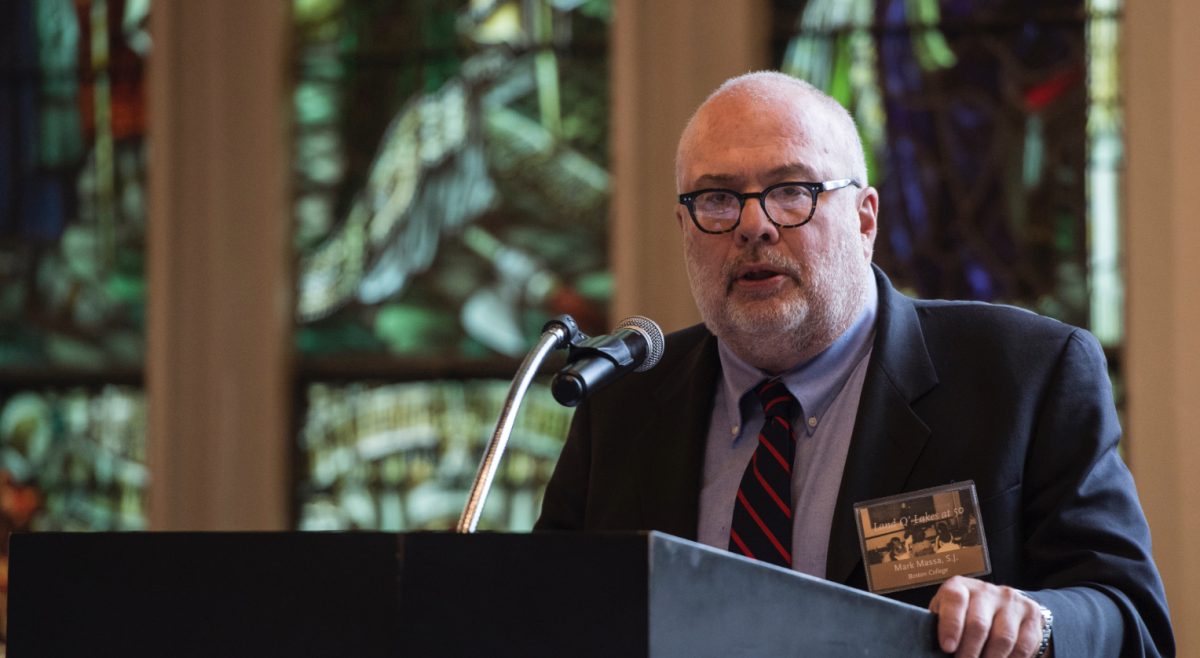Walking into the history department on the third floor of Stokes Hall and students will notice that some of the art on the walls is slightly atypical. At first glance, the oversized comic panels hanging on the walls look like pages torn from a Marvel comic book, but when students look a little closer, they will notice that each of the panels represents a significant historical theme, like Watergate, women’s liberation, or Sept. 11.
The Boston College history department teamed up with the Burns Library to create the Revealing America’s History Through Comics exhibit. The exhibit showcases panels that are compiled from various comic books to create a new story. Students in the Making History Public class, taught this semester by Heather Cox Richardson, combed through over 11,000 comic books donated by finance professor Edward Kane to create their panels.
Students in the class selected different panels from comics that related to make one story. They then added their own captions and dialogue to change the original story into a retelling of American history. They completed the project last spring, Richardson said.
This is the second time this class has been taught, Richardson said. The first time, the class was on books from 1400 to 1800 and was taught by Virginia Reinburg.
“The concept of the class is to get students actually using the archival sources,” Richardson said. “They have to figure out what’s important and digest it into their own form.”
Last semester, the course was taught by Lynn Johnson and was focused on the history of Boston Common. The students are designing the exhibit for that course, which should be done by the end of the year. Sylvia Sellers-Garcia is currently teaching the fourth iteration, called Early Maps and Distant Places, according to librarian Elliot Brandow.
“Part of the course is about researching the topic and developing their own academic expertise on a subject, and part is about conceiving a way to share their newfound expertise, ensuring that their insights will be accessible to an audience that might not know anything about the topic,” Brandow said.
Remy Hassett, a history and secondary education major and A&S ’14, was skeptical about a class revolving around comic books. She took it because she wanted to take a class with Richardson, but it ended up teaching her a new way to look at history, she said.
On the first day of class, students had to create their own syllabus, and there were a lot of disagreements. Ultimately, everything worked out and the class is proud of the exhibit, Hassett said.
Hassett compiled two panels based on advertisements and edited the entire collection. She worked with technology services to print the panels for the finished product.
“I’m not quite sure how I ended up with this job, but I did,” she said. “I ended up going through the proofs so many times just to make sure the text was proofread and to make sure that the panels themselves looked how we wanted them to, with the right size font and the correct width for the borders.”
Looking at historical events through the lens of DC and Marvel Comics was fascinating, she said. While researching, she found herself focusing more on the advertisements, though, than on the actual story lines.
“I was fascinated by how, amidst the pages of the comics, they were trying to teach boys to be men-growing facial hair, becoming more muscular, and selling GRIT newspapers, for instance,” Hassett said. “I realized how there was a dramatic shift in ads in the ’80s, ’90s, and 2000s as technology became more prevalent in our daily lives.”
The process gave her insight into a new way to teach history. She hopes to carry what she learned about the importance of seeing history in a new light to her future job as a history teacher, she said.
“I would have never thought to use comic books to teach history before, but the entire class loved it,” she said. “Also, the whole process of curating an exhibit is something I hope to do with my own students one day, regardless of the subject matter. I think it’s incredibly important for students to take ownership of their material, and curating an exhibit is an incredible way to do so, and for students to proudly display their work.” Brandow, the senior reference librarian and history bibliographer, helped students explore secondary sources for their papers.
Justine Sundaram, the Burns reference librarian, helped the students sort through the comic books.
“I enjoyed the energy that the students brought to the class and their exhibit,” Brandow said. “There is something about the excitement of creating a project that has life beyond the confines of the individual class and producing material that will be shared with an audience beyond the professor that adds vibrancy and energy to this course.”
Watching the students interpret history and produce an exhibit is wonderful, Richardson said. “I turned them loose into the comics,” she said. “They got into the collection and fell in love with it.”






